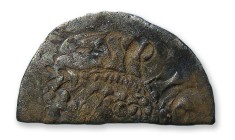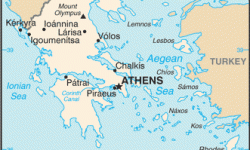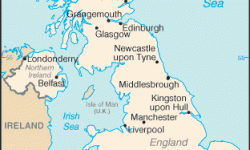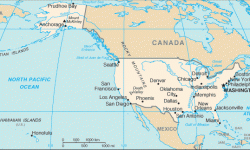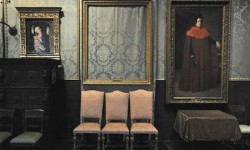Corinth Museum Theft 1990
Author: Neil Brodie
Last Modified: 05 May 2015
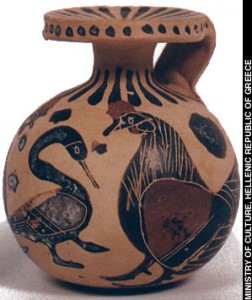
In 1990 thieves stole more than 270 artifacts from the museum of the Corinth excavations in Greece. Several pieces were recovered from Christie’s New York in the late 1990s, while most of the remainder were discovered in Miami in 1999.
On the night of 12 April 1990, thieves broke into the museum of the Corinth excavations in Greece. After assaulting the guard, the thieves forced open display cases and made off with more than 270 ancient Greek and Roman artefacts, recovered during 90 years of work by the American School of Classical Studies in Athens (ASCSA) (Bookidis 2007: 119–120). ASCSA staff quickly prepared an inventory of the stolen objects, including photographs, which was forwarded to the Greek Archaeological Service and Greek police (Bookidis 2007: 121). ASCSA also subsidised the June 1990 issue of IFAR Reports that documented with images the stolen objects (IFAR 1990). The theft was also reported in the September 1990 issue of Minerva, where some of the stolen pieces were illustrated (Aspropoulos 1990: 24–25).
The burglary was the work of the so-called Karahalios gang, comprising Anastasios Karahalios, his father and brother, both called Tryfonas, together with one Ioannis Loris (Axarlis 2000; 2001; Ζηργάνος 2008). By 1993, the stolen material was in Miami, where some was being stored at the home of Wilma Sabala, apparently a friend of the younger Tryfonas Karahalios. In December 1997 and March 1998, Sabala sold five pieces by auction at Christie’s New York for a total of $17,800 (Axarlis 2001), including lot 103, 18 December 1997, two Attic black-figure cups, advertised as ‘The Property of an American Private Collector’, which had previously been published by ASCSA (Blegen et al. 1964: 211, nos 250–14 and 250– 15, pls. 35, 93) and listed by IFAR (IFAR 1990: nos. 759, 760). Three of the five pieces were bought by Jerome Eisenberg, editor of Minerva and proprietor of Royal Athena Galleries in New York City (Axarlis 2001). Eisenberg published one of the purchased pieces in one of his own catalogues, whereupon it was recognised by interested academics as stolen from Corinth. Eisenberg contacted the FBI and returned all three pieces, denying any knowledge that the pieces were stolen (Axarlis 2001; Bookidis 2007: 123–124).
On 7 September 1999, FBI agents in collaboration with Greek police recovered another 265 of the stolen objects in twelve plastic boxes hidden in crates of fresh fish in a Miami warehouse (Axarlis 2001; USA 2001). Fourteen pieces were still registered missing, including three marble heads of Julius Caesar, Serapis and Eros, which were also subsequently recovered from Christie’s New York (Bookidis 2007: 124). The head of Julius Caesar (IFAR 1990: no. 682; Datsoulis-Stavrides 1970: 109–110, fig. 1) was offered with no provenance as lot 136 in June 1999. The head of Serapis (IFAR 1990: no. 687; Morgan 1937: 539–40, fig. 1) had been subject to some minor conservation work to make it more saleable, and a hole had been drilled for mounting on a base (Bookidis 2007: 124, note 12); it was offered with no provenance as lot 326 in the December 1999 auction. Christie’s did not divulge the name of the consignor (Bookidis 2007: 124). On 22 January 2001, the Greek Ministry of Culture announced the return to Greece of 274 objects, with eleven still missing (Axarlis 2001; USA 2001).
Sabala was arrested in Miami in June 2000 and subsequently pled guilty to interstate transport of stolen property (Axarlis 2001). In January 2000, Greek police arrested Anastasios Karahalios, discovering in his home guns, drugs and other antiquities (Axarlis 2001). Loris was also arrested, but Tryfonas (sr) and Tryfonas (jr) were believed to be hiding in Venezuela (Axarlis 2001). On 29 January 2001, Anastasios Karahalios was convicted and sentenced to life imprisonment. Loris was acquitted (Axarlis 2001b). In March 2001, Tryfonas Karahalios (jr) was arrested in Greece for importing 25 kilos of cocaine from Venezuela routed through the Netherlands and Cyprus (ANA 2001a; 2001b), and subsequently convicted of the Corinth thefts (Ζηργάνος 2008).
The younger Tryfonas has always denied involvement with the thefts, and in 2008 the two brothers recounted their own version of events (Ζηργάνος 2008). Anastasios claimed to have been approached by two Greek-Americans who were friends of his uncle living in Miami George Karahalios, and who were planning to steal to order for a German collector specific pieces from the Corinth Museum. The actual theft was carried out by Anastasios and some fellow Greeks, while the Greek- American organisers waited outside. It was not possible for the thieves to remove all the requested pieces, so the Greek-Americans ordered them back instead to take what they could get. The stolen material was transported by yacht to Turkey, and then overland by truck to Aachen, Germany. By this time, because the pieces stolen were not the ‘ordered’ ones and because of the bad publicity accompanying the theft, the prospective purchaser had lost interest, and so the material was then transported via container to Miami, where it was stored in the attic of a house belonging to George Karahalios. By 1997 George Karahalios had died and his house was hit by hurricane ‘Andrew’, breaking open some of the boxes in the attic and revealing their contents. Sabbala, who it seems was the girlfriend of George Karahalios, started selling some of the material through Christie’s. It was then that Tryfonas became involved, moving the material to a new hiding place, and offering through an intermediary to arrange the return of the stolen material in return for a reward. The intermediary was then able to direct the FBI and collaborating Greek police to secure the recovery of the stolen material.
References
ANA (2001a), Arrest-cocaine-import, Athens News Agency, 1 March. Available at: http://mail.hri.org/news/greek/apeen/2001/01-03-01.apeen.html#03, accessed 25 February 2013.
ANA (2001b), Gym chain owner arrested in Peru cocaine trafficking case, Athens News Agency, 21 July. Available at: http://www.hri.org/news/greek/ana/2001/01-07- 21.ana.html#20, accessed 25 February 2013.
Aspropoulos, Stavros (1990), ‘Corinth Museum looted’, Minerva, 1(7), 23–25.
Axarlis, Nikos (2000), Greek antiquities ring broken up, Archaeology online, 1 February. Available at: http://archive.archaeology.org/online/news/corinth.html, accessed 25 February 2013.
Axarlis, Nikos (2001), Corinth antiquities returned, Archaeology online, 6 February. Available at: http://archive.archaeology.org/online/features/corinth/index.html, accessed 25 February 2013.
Blegen, W., Palmer, H. and R. S. Young (1964), Corinth XIII. The North Cemetery (Princeton: Princeton University Press).
Bookidis, Nancy (2007), ‘The Corinth Theft’, in Robin F. Rhodes (ed.), The Acquisition and Exhibition of Classical Antiquities (Notre Dame: University of Notre Dame), 119–131.
Datsoulis-Stavrides, A. (1970), ‘Tête de Jules César au Musée de Corinthe’, Athens Annals of Archaeology 3, 109–10.
IFAR (1990), Special Issue: Theft at Ancient Corinth, Greece, IFAR Reports, June (New York: International Foundation for Art Research).
Morgan, C.H. (1937), ‘Excavations at Corinth, 1936-1937’, American Journal of Archaeology 41, 539–52.
USA (2001), ‘Stolen Corinth artifacts return to Greek authorities’, press release, 18 January (Athens: US Embassy).
Ζηργάνος, Νικόλας (2008), ‘Τα αρχαία βρέθηκαν, οι κλέφτες όμως χάθηκαν’, Πολἱτης, 25 January.
